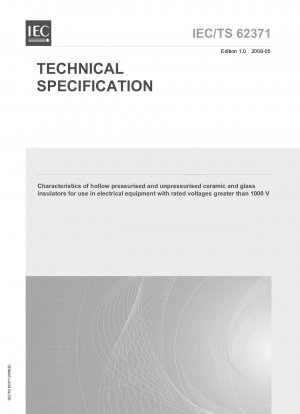IEC TS 62371:2008
Characteristics of hollow pressurised and unpressurised ceramic and glass insulators for use in electrical equipment with rated voltages greater than 1000 V
- Standard No.
- IEC TS 62371:2008
- Release Date
- 2008
- Published By
- International Electrotechnical Commission (IEC)
- Latest
- IEC TS 62371:2008
- Replace
- IEC 36C/172/DTS:2007
- Scope
- This Technical Specification applies to - ceramic and glass hollow insulators intended for general use in electrical equipment; - ceramic hollow insulators intended for use with a permanent gas pressure in switchgear and controlgear. They are intended for indoor and outdoor use in electrical equipment, operating on alternating current with a rated voltage greater than 1 000 V and a frequency not greater than 100 Hz or for use in direct current equipment with a rated voltage greater than 1 500 V. This specification specifies the dimensional and mechanical characteristics of the hollow insulator, which are essential for interchangeability of the hollow insulator of the same type. It is not the object of this specification to prescribe electrical characteristics because they are dependent on the apparatus of which the hollow insulator ultimately forms a part. However, standard lightning impulse withstand voltage which is provided in IEC 60071-1 is described only for reference for classification purpose. This specification applies to hollow insulators for use in electrical equipment in clean areas or lightly polluted areas, where seismic qualification is not required. For use in areas characterised by heavy pollution levels and for other particular or extreme environmental conditions such as seismic force, it may be necessary for certain dimensions to be changed. The hollow insulators covered by this specification are: a) straight type hollow insulators with metal fittings on both ends; b) taper type hollow insulators with metal fittings on both ends; c) straight type hollow insulators without metal fittings; d) taper type hollow insulators without metal fittings. The hollow insulators are intended for use in electrical equipment, for example: - circuit-breakers; - instrument transformers; - surge arresters; - bushings; - cable sealing ends; - switch-disconnectors; - disconnectors; - earthing switches; - capacitors. There may be some cases that hollow insulators whose design can strongly be influenced by other components of specific equipment, for example, active parts of circuit-breakers. For such cases, the hollow insulators can be separately designed, depending on respective requirements of such equipment and not be covered by this specification. NOTE 1 Hollow insulators not prescribed in this specification can also be applied to electrical equipment, depending on specific requirements of the equipment. However, if similar insulators are available in this specification, it is preferable to apply them. NOTE 2 For general recommendations for design and tests of the hollow insulators, see IEC 62155 NOTE 3 For characteristics of hollow insulators for use in polluted areas, reference can be made to IEC 60815- 1and IEC 60815-2.
IEC TS 62371:2008 Referenced Document
- IEC 62155 Hollow pressurized and unpressurized ceramic and glass insulators for use in electrical equipment with rated voltages greater than 1000 V
IEC TS 62371:2008 history
- 2008 IEC TS 62371:2008 Characteristics of hollow pressurised and unpressurised ceramic and glass insulators for use in electrical equipment with rated voltages greater than 1000 V
IEC TS 62371:2008 Characteristics of hollow pressurised and unpressurised ceramic and glass insulators for use in electrical equipment with rated voltages greater than 1000 V has been changed from IEC 36C/172/DTS:2007 IEC/TS 62371, Ed. 1.0: Characteristics of hollow pressurised and unpressurised ceramic and glass insulators for use in electrical equipment with rated voltages greater than 1000 V.
